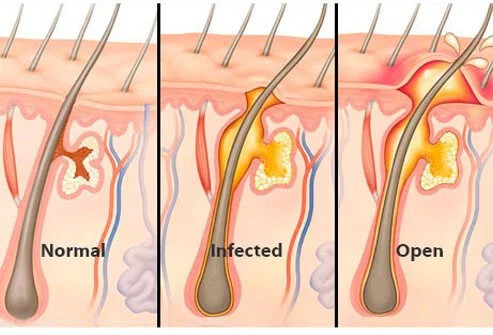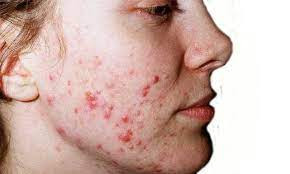Definition
Acne neonatorum, also known as baby acne, neonatal acne, or neonatal cephalic pustulosis, is a type of acne that occurs in newborn babies. It typically manifests as small red dots on the cheeks, forehead, and nose, typically starting between 2 to 6 weeks of age. Although it may concern parents who expect their baby's skin to be blemish-free, neonatal acne is a common condition, affecting approximately 20% of healthy infants worldwide.
Baby acne is classified into two distinct types:
- Acne neonatorum
This type of acne manifests in babies between the ages of 2 and 6 weeks. It usually will resolve on its own within 3 to 4 months. This syndrome frequently manifests in newborns and infants and poses no significant risk.
- Infantile acne
A condition known as infantile acne often occurs in babies between the ages of 6 weeks and 12 months. This skin problem typically is more severe compared to acne neonatorum. Consult with a dermatologist if your child develops acne when he is more than 6 weeks of age.
You should know how to distinguish between acne neonatorum and rashes in babies.
- Baby heat rash, also known as miliaria, manifests as small red bumps resembling acne. It typically occurs on the extremities, chest, and buttocks areas that have been covered by diapers. This rash develops following exposure of the baby's skin to high temperatures or sunlight.
- Diaper rash is characterized by an erythematous rash that occurs in the skin area covered by diapers due to prolonged use of diapers under moist environments.
- Cradle cap, also known as seborrheic dermatitis, is a small red bump accompanied by flaky skin and yellow scales on a baby's face, scalp, and eyebrows.
- Eczema is an allergic skin disorder characterized by dry and reddish skin on the cheeks, scalp, and elbows. The reddened skin could transform into pimples filled with pus that is prone to rupture.
Causes
The cause of acne neonatorum remains uncertain. The inflammatory response of the body to fungus is believed to be the possible cause of acne neonatorum. This condition is distinct from the acne seen in teenagers and adults throughout puberty, as it is not caused by hormonal changes associated with adolescence. Other experts believe that neonatal acne may be linked to hormones from the mother to the fetus in pregnancy. The mother's hormones activate the sweat glands of the newborn, causing them to secrete oil. Additionally, some infants possess highly sensitive skin, rendering them susceptible to acne.
Acne neonatorum is not an allergic disorder and is unrelated to either breast milk or formula milk. The inflammatory reaction occurring in this disease is normal for babies.
Risk factor
Acne neonatorum is more common in:
- Male infant
- Full-term infants (37 to 40 weeks of age) as opposed to premature infants
- Infants with high birth weight
- Babies born during the summer or autumn
Symptoms
Symptoms of acne neonatorum include:
- Red dots, bumps, or pustules resembling pimples, with pus inside and a dot of pus in the middle
- Acne can be found on the baby's cheeks, forehead, and scalp
- Less commonly, acne may appear on the neck, chest, arms, and legs
- The number and size of pimples can vary greatly
- Pressing on the pimples will cause the reddish color to disappear
- The color of the acne may become more pronounced when the baby cries
- There are no blackheads present
- Acne does not appear on the palms of the hands or soles of the feet
Some babies may develop acne neonatorum between 3 to 14 days of age, while other babies may experience a reddish rash within 48 hours of birth. Acne neonatorum can also be present from birth.
Diagnosis
Acne neonatorum will be diagnosed by the doctor after conducting a physical examination. They will examine the infant's skin to check the acne and assess the accompanying inflammatory response surrounding the pimples. There are no specific tests that need to be done. The doctor would distinguish acne neonatorum from other skin conditions, such as milia. Milia presents as white or translucent bumps, but acne neonatorum resembles adult acne. Nevertheless, both of these conditions are managed in the same way, which involves keeping proper hygiene and closely monitoring the presence of acne.
Acne neonatorum may be linked to other illnesses, including congenital adrenal hyperplasia (CAH) and other hormonal disorders. Nevertheless, this occurrence is exceedingly rare, and the primary manifestations that arise would not be acne, but rather excessive facial hair growth and very oily skin.
If acne manifests beyond 6 weeks of age, your dermatologist would verify its nature whether it is acne or not, conduct a thorough examination for any underlying causes, assess the products used for the baby, and take measures to prevent the formation of acne scars.
Management
Acne neonatorum typically manifests for a few days and resolves within 2 to 12 weeks.
Home Care
- Try to remain calm, typically your baby will not experience any discomfort from the acne (there is absence of itching, scratching, fever, or fussiness)
- Avoid applying pressure, extracting, or massaging pimples as this might lead to bacterial infection
- Thoroughly cleanse the affected area with warm water twice daily, followed by gentle drying with a cloth
- Saliva, remnants of milk or vomit can exacerbate acne, hence it is necessary to frequently cleanse the baby's body
- Avoid giving your baby too many baths and avoid using soap to cleanse the affected area sparingly, as this may lead to dry your baby's skin
- Avoid using soap or lotion to areas affected by acne
- Refrain from utilizing acne products designed for adults
- If the acne persists for 3 months, it is advisable to seek medical advice for the condition. Before using any medications, it is recommended to consult a medical professional.
Although some mothers have reported success in decreasing acne by topically administering breast milk, there is currently no scientific data to support this claim.
Medical Treatment
Acne neonatorum typically resolves spontaneously in 3 months without the need for medical attention. If your doctor identifies signs warranting treatment, they will treat the lesions. For example, they could prescribe antibiotics in the case of a bacterial infection, antifungal drugs if a fungal infection is suspected, or low-potency steroid drugs like hydrocortisone if needed.
Complications
Acne neonatorum has the potential to resolve on its own without any specific complications. Acne neonatorum does not cause any long-term consequences. Infantile acne can lead to the formation of acne scars, although acne neonatorum does not result in the development of such scars. Acne may resurface within 6 weeks after birth, but it will resolve spontaneously. If acne emerges after 6 weeks of age, it is advisable to consult a doctor and have your baby's skin assessed.
Prevention
There are no specific ways to prevent neonatal acne. To avoid exacerbating the problem, refrain from squeezing pimples and you can do the above steps in the home care section.
When to see a doctor?
Acne neonatorum may resolve spontaneously without needing specific intervention. If the acne appears to be getting worse, turning redder, your baby is experiencing fever, the acne persists for more than 3 months, or if you fear an allergic reaction, it is advisable to consult a doctor or dermatologist for further advice.
If you experience uncertainty or concern over the condition you are experiencing, it is advisable to consult a pediatrician or dermatologist.
Looking for more information about skin and other hair diseases? read more articles here!
- dr Hanifa Rahma
American Academy of Dermatology Association. Is that acne on my baby's face?. Available from: https://www.aad.org/public/diseases/acne/really-acne/baby-acne
Brennan, D. (2021). What to know about proper hygine for baby acne. WebMD. Available from: https://www.webmd.com/parenting/baby/what-to-know-baby-acne-proper-hygiene
Cleveland Clinic. (2018). Acne neonatorum. Available from: https://my.clevelandclinic.org/health/diseases/17822-baby-acne
Gill, K. (2018). Baby Acne: causes, treatments, and more. Healthline. Available from: https://www.healthline.com/health/childrens-health/baby-acne#
Poole, CN., McNair, V. Infantile Acne. [Updated 2021 Jul 15]. In: StatPearls [Internet]. Treasure Island (FL): StatPearls Publishing; 2022 Jan-. Available from: https://www.ncbi.nlm.nih.gov/books/NBK541124/
Masters, M., Crosby, L. (2020). Baby acne: what to do if your infant has it. Available from: https://www.whattoexpect.com/first-year/baby-care/baby-skin-care/infant-acne.aspx
Siegfried, E. (2017). Neonatal acne. Dermatology Advisor. Available from: https://www.dermatologyadvisor.com/home/decision-support-in-medicine/dermatology/neonatal-acne-acne-neonatal-and-infantile/












